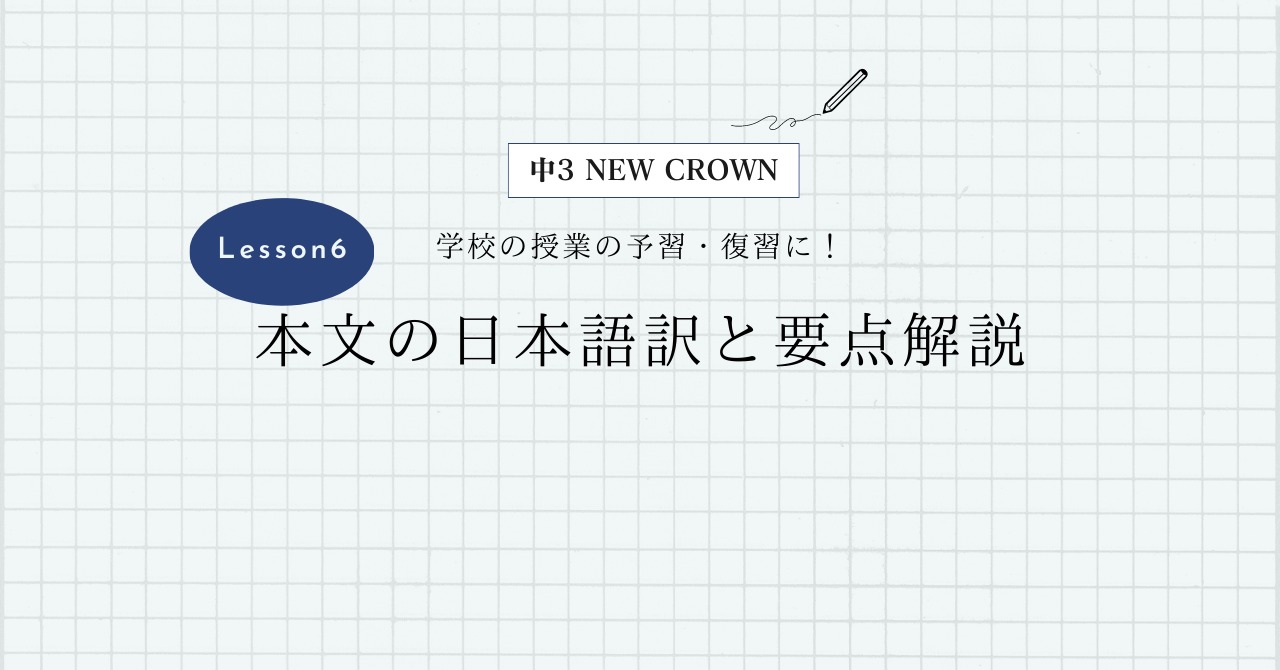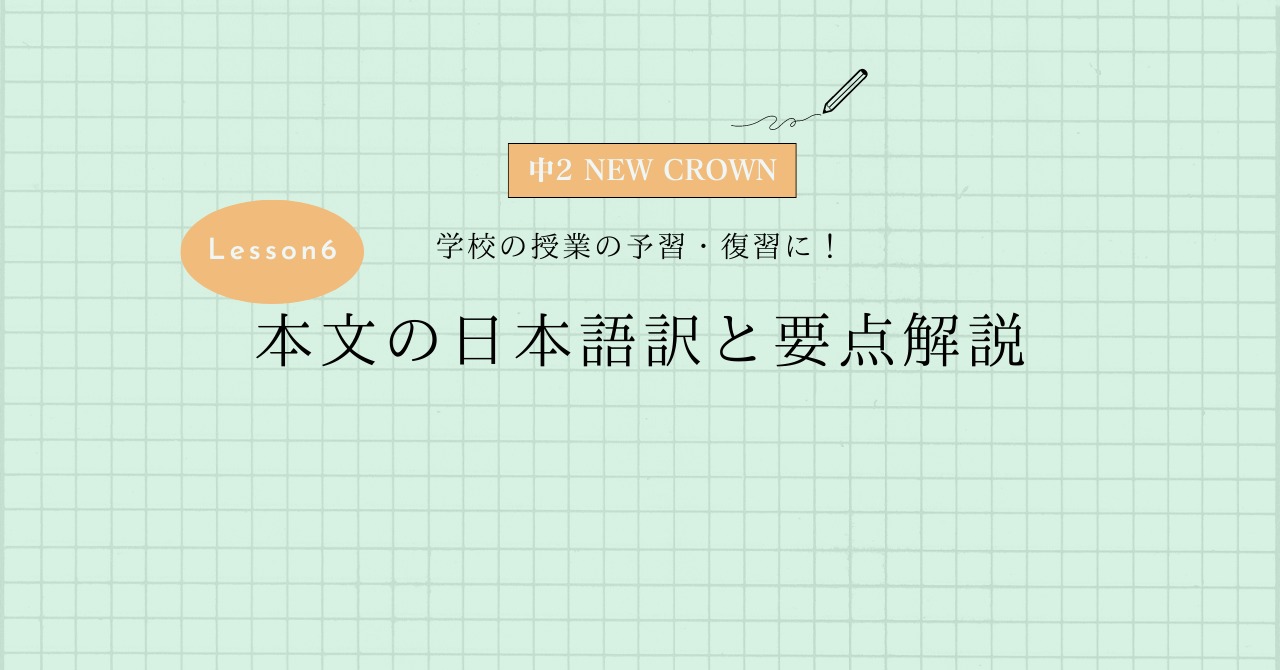三省堂 中学3年生 NEW CROWN(ニュークラウン) Lesson6 Part3の本文の日本語訳と重要箇所の解説です。
Lesson6-1,6-2の解説はこちらからご覧ください。
>中3NEW CROWN Lesson6 Part1 本文和訳
>中3NEW CROWN Lesson6 Part2 本文和訳
- Lesson6 Part3 本文と日本語訳
- Lesson6 Part3 重要事項の解説
- How to Create New Ideas
- My dream is to invent a time machine.
- It is something I have been thinking of for a long time.
- You might think I am a dreamer, but all new things start as dreams.
- I have learned from past dreamers how to create something new for the future.
- Today nobody thinks about flying.
- It is not new or especially exciting.
- It was not always so.
- For centuries the dream of traveling by air interested inventors, like Leonardo da Vinci.
- He thought, “I wish I could fly like a bird.” He and others studied birds.
- Gradually they learned some of the secrets of flight.
- The earliest aircraft were ridiculous.
- One inventor tied an umbrella and wings to a chair.
- Another made a duck-like machine.
- People made fun of them.
- However, the inventors used their imaginations in quite unexpected ways.
- They led to the invention of the modern airplane.
- You need a mind full of ideas in order to create something new.
- This is the first thing I have learned.
- The Wright Brothers made the first successful flight in 1903.
- Before this flight, they made a lot of experiments.
- They tested their ideas over and over again.
- Sometimes, their gliders broke into pieces.
- Other times, the brothers found out that the wings did not work.
- However, they never gave up.
- As soon as they noticed a problem, they looked for a solution.
- The brothers knew that they had to learn from the failure.
- They were not afraid of it. They welcomed it.
- The stories taught me two important things.
- First, we should not hesitate to come up with new and original ideas.
- Using our imagination is the key to starting off.
- Second, I realized that we should learn from failure.
- It is better to do something and fail than to do nothing and learn nothing.
- This is the message I will leave with you:
- have the courage to imagine and the courage to act in your personal and public lives.
- Lesson6 Part3 まとめ
Lesson6 Part3 本文と日本語訳
How to Create New Ideas
「新しいアイディアを生み出す方法」
My dream is to invent a time machine.
「僕の夢はタイムマシーンを発明することです。」
If I had one, I would visit great inventors across the ages.
「もしタイムマシーンがあったら,僕は時代を越えて偉大な発明家のもとを訪れるでしょう。」
It is something I have been thinking of for a long time.
「それが,僕が長い間考え続けていることです。」
You might think I am a dreamer, but all new things start as dreams.
「あなたは,僕は夢想家だと思うかもしれませんが,すべての新しいことは夢として始まります。」
I have learned from past dreamers how to create something new for the future.
「僕は過去の夢想家たちから,未来のための新しい何かを創る方法を学んできました。」
Today nobody thinks about flying.
「今日では,誰も飛ぶことについて考えません。」
It is not new or especially exciting.
「飛ぶことは新しいことでも特別ワクワクすることでもありません。」
It was not always so.
「飛ぶことはいつもそうだったわけではありません。」
For centuries the dream of traveling by air interested inventors, like Leonardo da Vinci.
「数世紀もの間,飛行機で旅するという夢はレオナルド・ダ・ヴィンチのような発明家の興味を引いてきました。」
He thought, “I wish I could fly like a bird.” He and others studied birds.
「彼は『鳥のように飛べたらなあ。』と思っていました。彼とその他の人たちは鳥のことを勉強しました。」
They watched feathers in the wind.
「彼らは風の中の羽を観察しました。」
Gradually they learned some of the secrets of flight.
「次第に,彼らは飛行の秘密のいくつかを学びました。」
The earliest aircraft were ridiculous.
「最古の航空機は滑稽なものでした。」
One inventor tied an umbrella and wings to a chair.
「ある発明家は傘と翼を椅子に結びつけました。」
Another made a duck-like machine.
「別の発明家はアヒルのような機械を作りました。」
People made fun of them.
「人々はそれらをからかいました。」
However, the inventors used their imaginations in quite unexpected ways.
「しかし,その発明家たちはまったく思いがけない方法で想像力を使いました。」
They led to the invention of the modern airplane.
「彼らが現代の飛行機の発明に導きました。」
You need a mind full of ideas in order to create something new.
「新しい何かを創るためにはたくさんのアイディアが必要です。」
This is the first thing I have learned.
「これが僕が学んだ最初のことです。」
The Wright Brothers made the first successful flight in 1903.
「ライト兄弟は1903年に最初の飛行を成功させました。」
Before this flight, they made a lot of experiments.
「この飛行の前に,彼らはたくさんの実験を行いました。」
They tested their ideas over and over again.
「彼らは何度も何度もアイディアを試しました。」
Sometimes, their gliders broke into pieces.
「時には,グライダーが粉々になりました。」
Other times, the brothers found out that the wings did not work.
「別の時には,翼が動かないと分かりました。」
However, they never gave up.
「しかし,彼らは決してあきらめませんでした。」
As soon as they noticed a problem, they looked for a solution.
「問題に気づくとすぐに,彼らは解決策を探しました。」
The brothers knew that they had to learn from the failure.
「兄弟は,失敗から学ばなけらばならないことを知っていました。」
They were not afraid of it. They welcomed it.
「彼らは失敗を恐れませんでした。失敗を歓迎していました。」
The stories taught me two important things.
「この話は僕に2つの大切なことを教えてくれました。」
First, we should not hesitate to come up with new and original ideas.
「1つ目は,新しくて独創的なアイディアを思い付くことをためらうべきではないということです。」
Using our imagination is the key to starting off.
「想像力を使うことが出発するための鍵です。」
Second, I realized that we should learn from failure.
「2つ目は,失敗から学ぶべきだと気づきました。」
It is better to do something and fail than to do nothing and learn nothing.
「何かをして失敗することは,何もしないで何も学ばないことよりも良いことです。」
This is the message I will leave with you:
「これが,僕があなたたちに残すメッセージです。」
have the courage to imagine and the courage to act in your personal and public lives.
「公私の生活で,想像する勇気と行動する勇気を持ちましょう。」
Thank you for listening.
「ご清聴ありがとうございました。」
Wakaba Junior High School
Kato Riku

Lesson6 Part3 重要事項の解説
How to Create New Ideas
ここでは「疑問詞+不定詞」が使われていますね。“how to 動詞の原形”は「~のしかた,~する方法,どのように~すべきか」のどれかで訳してあげましょう。
“create”は「を創造する,を生み出す」という動詞です。
My dream is to invent a time machine.
“to invent”は「不定詞の名詞的用法」になっていますね。
“invent”は「を発明する」という動詞です。
It is something I have been thinking of for a long time.
“It”は“to invent a time machine”を指していますね。“something”は「何か」と漠然としたものを指す代名詞です。
この文では「目的格の関係代名詞」が使われていますね。関係代名詞“which/that”は省略されています。
“I have been thinking of”が先行詞“something”を修飾しています。
また,“have been thinking of”は「現在完了進行形」にもなっていますね。“think of~”で「~について考える」という意味になります。
“for a long time”は「長い間」という重要表現です。
You might think I am a dreamer, but all new things start as dreams.
“might”は助動詞で“may”の過去形になりますが,現在形の文でも使うことができます。
その場合は“may”よりも確信度が低いニュアンスの「~かもしれない」という意味になります。
また,“think”の後ろには「接続詞that」が省略されていますね。
“as”は前置詞で「~として」という意味です。
I have learned from past dreamers how to create something new for the future.
この文でも「現在完了」が使われていますね。“past”は「過去」という名詞です。
用法としては「継続用法」が1番近いかなと思います。
また,「疑問詞+不定詞」も使われていますね。
“something”などの“-thing”の形で終わる名詞を修飾するときは,形容詞を後ろに置いて修飾してあげます。“new something”としないように要注意です!
Today nobody thinks about flying.
“nobody”は「誰も~ない」という名詞で,文章が否定形の意味になります。
“flying”は「動名詞」になっていますね。
It is not new or especially exciting.
“It”は“flying”を指していますね。
“especially”は「特に」という副詞になります。
It was not always so.
この“It”も“flying”を指していますね。
“not always”の組み合わせは,「いつも~というわけではない」という部分否定の意味になります。
“so”は直前の“not new or especially exciting”を指していて,「それ(飛ぶこと)はいつも新しくないとか特にワクワクさせるものではないと思われていたわけではない。」という意味になります。
つまり「かつては新しかったりワクワクさせるものと思われていた」ということですね。
For centuries the dream of traveling by air interested inventors, like Leonardo da Vinci.
“century”は「世紀」という名詞で,“for centuries”で「数世紀の間」となります。
“traveling”は「動名詞」になっていて,“air”は「飛行機」なので“by air”は「飛行機で」という交通手段を表します。
“interest”は「の興味を引く」という動詞になります。“inventor”は「発明家」という名詞ですね。
“like”は前置詞で「~のような」という重要単語です。
He thought, “I wish I could fly like a bird.” He and others studied birds.
この文では「I wish+仮定法過去」が使われていますね。
この“like”も前置詞で「~のような」です。
“other”は「他者」という名詞になります。
Gradually they learned some of the secrets of flight.
“gradually”は「次第に,徐々に」という副詞になります。
“they”は“He and others”を指していますね。
“some of~”は「~のいくつか」という意味で,“secret”が「秘密」,“flight”は「飛行」という名詞になります。
The earliest aircraft were ridiculous.
“earliest”は「最古の」という形容詞になります。“aircraft”は「航空機」という名詞ですね。
“ridiculous”は「滑稽な,ばかげた」という形容詞です。
One inventor tied an umbrella and wings to a chair.
“one”は「ある」くらいで訳してあげましょう。
“tie”は「を結ぶ」という動詞で,“wing”は「翼」という名詞です。
Another made a duck-like machine.
“another”は「他の人,他の」という意味になります。今回は名詞ですね。
“duck-like”は「アヒルのような」という意味で,“machine”は「機械」という名詞です。
People made fun of them.
“make fun of~”は「をからかう」という意味になります。
“them”はこの前に出てきた椅子に傘と翼を結び付けたものと,アヒルのような機械のことを指していますね。
However, the inventors used their imaginations in quite unexpected ways.
“however”は「しかし」という意味の副詞になります。
同じ意味で“but”がありますが,こちらは接続詞なので品詞が異なります。“but”は“文A,but 文B”というように,2つの文を繋ぐ際に使います。
“文A. But 文B.”というように,“but”を文の先頭に置いて1文だけで完結させるのは原則NGとなります。
“imagination”は「想像力」という名詞です。
“quite”は「かなり,極めて」という副詞で,“unexpected”は「思いがけない」という形容詞です。
“in ~ way”は「~の方法で」となります。
They led to the invention of the modern airplane.
“They”は“the inventors”を指していますね。
“led”は“lead(導く)”の過去形で,“invention”は「発明」,“airplane”は「飛行機」という名詞です。
“modern”は「現代の」という形容詞ですね。
“of”は前置詞で,”A of B”の形で「BのA」というように後ろから前に訳します。
You need a mind full of ideas in order to create something new.
“need”は「を必要とする」という動詞ですね。
“mind”は「精神,心」といった名詞です。ただ,今回は訳に入れると少し変になってしまうので,訳していません。
“full of~”は「~でいっぱいな」という形容詞で,このように形容詞を含む2語以上のかたまりで名詞を修飾するときは,修飾したい名詞の後ろに置きます。
“in order to 動詞の原形”は「~するために」という「不定詞の副詞的用法」と同じ意味になります。
This is the first thing I have learned.
この文では「目的格の関係代名詞」が使われていますね。関係代名詞“which/that”は省略されています。
“I have learned”が先行詞“thing”を修飾しています。
また,この文でも「現在完了」が使われていますね。
The Wright Brothers made the first successful flight in 1903.
“successful”は「成功した」という形容詞になります。
ただ,「成功した飛行」と直訳すると変な日本語になるので,「最初の飛行を成功させた」と訳しました。
Before this flight, they made a lot of experiments.
“before”は「~の前で」という前置詞です。
“experiment”は「実験」という名詞です。
They tested their ideas over and over again.
“test”は「を試す,テストする」という動詞になります。
“over and over again”は「何度も何度も」という表現です。
Sometimes, their gliders broke into pieces.
“sometimes”は「時々」という副詞ですね。“glider”は「グライダー」です。
“break into pieces”は「粉々になる」という表現になります。
“broke”は“break”の過去形ですね。
Other times, the brothers found out that the wings did not work.
“found”は“find”の過去形で,“find out”で「~と分かる」という意味になります。後ろには「接続詞that」を置くことが多いです。
“work”は「働く,動く,作動する」という動詞ですね。
However, they never gave up.
“give up”は「諦める」という重要表現です。
“never”は「決して~ない」という強い否定を表す副詞で,“never give up” の形でよく使われますね。
As soon as they noticed a problem, they looked for a solution.
“as soon as”は「~するとすぐに」という接続詞になります。
“notice”は「に気づく」という動詞で,“look for~”は「~を探す」という重要表現です。
“solution”は「解決策」という名詞になります。
The brothers knew that they had to learn from the failure.
この文でも「接続詞that」が使われていますね。
“had to 動詞の原形”は「~しなければならなかった」という,“have to”の過去形です。
“failure”は「失敗」という名詞ですね。
They were not afraid of it. They welcomed it.
“be afraid of~”は「~を恐れる」という重要表現です。
“it”は“failure”を指していますね。
“welcome”は「を歓迎する」という動詞になります。
The stories taught me two important things.
“teach 人 もの”で「人にものを教える」となって,“teach もの to 人”でも同じ意味になります。
他には“tell”, “tell”, “give”などが同じ使い方をできるので必ず書き換えられるようにしておきましょう。
First, we should not hesitate to come up with new and original ideas.
“should”は「~すべきだ,~のはずだ」という助動詞ですね。
“hesitate to 動詞の原形”で「~するのをためらう」という意味になります。
“come up with~”は「を思い付く」という表現です。
“original”は「最初の,独創的な」という形容詞になります。
Using our imagination is the key to starting off.
“using”と“starting off”は「動名詞」になっていますね。
“key”は「鍵」という名詞で,“start off”は「動き出す,着手する」といった意味です。
Second, I realized that we should learn from failure.
“realize”は「を理解する,悟る,気づく」という動詞です。
そしてこの文でも「接続詞that」が使われていますね。
It is better to do something and fail than to do nothing and learn nothing.
この文では「it to構文」が使われていますね。“fail”は「失敗する」という動詞です。
“nothing”は「何も~ない」という代名詞になります。
また,ここでは「比較級」も使われていますね。
This is the message I will leave with you:
この文では「目的格の関係代名詞」が使われていますね。関係代名詞“which/that”は省略されています。
“I will leave”が先行詞“the message”を修飾しています。
“leave”は「出発する,去る」といった,「ある場所から離れる」というイメージを持つ動詞です。訳は文章に応じて柔軟に変えてあげましょう。
また,「を置き忘れる,残す,ままにする」といった意味もありますよ!今回はこっちの「を残す」の意味ですね。
have the courage to imagine and the courage to act in your personal and public lives.
“courage”は「勇気」という名詞です。“imagine”は「想像する」,“act”は「行動する」という動詞ですね。
そして“to imagine”と“to act”はどちらも「不定詞の形容詞的用法」になっていて,直前の“courage”を修飾しています。
“personal”は「個人的な」,“public”は「公共の」という形容詞で,“lives”が“life(生活)”の複数形なので,まとめて「公私の生活」と訳しました。
“lives”のように,語尾が”f,fe”で終わる名詞を複数形にするときは”f,fe”を取って”ves”をつけます。
knife→knives(ナイフ), leaf→leaves(葉)などがあります。
Lesson6 Part3 まとめ
以上がLesson6 Part3の日本語訳となります。
ここでは「I wish+仮定法過去」や「関係代名詞」が使われていますね。用法と訳し方をしっかり理解していきましょう!
>中3NEW CROWN Lesson6 Part1 本文和訳
>中3NEW CROWN Lesson6 Part2 本文和訳
何か分からない点や他に解説してほしい点があれば,お気軽にコメントしてください!




コメント